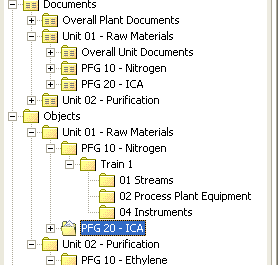Key Benefits
- Introduce standards and procedures to aid work processes
- Simplify document access
- Simplify equipment access
- Reuse on future projects
Plant / Work Breakdown
This area of technology is most likely to suit Engineering Procurement Contractors (EPC's). However, it is often that other verticals will also use the technology such as Licensors and Owner Operators.
This particular customer was already well versed with automation and had established a tool set that enabled them to produce end deliverables with some proficiency. However, they wanted more from the tools to include more sophisticated engineering features and to improve their overall work processes.
Our brief from the customer was to provide a Plant Breakdown Structure (PBS) from a configuration file (to be reused and modified for different projects with limited effort), that allowed automatic filing of documents and objects.
The configuration file was much more than a definition of the PBS, it also had to consider naming conventions, disallow filing of equipment in inappropriate PBS folders and much more.
This particular implementation looks at the problems and the challenges faced with providing flexible capabilities that allow EPC's to quickly use automation tools with minimum setup time.
Background

The Plant / Work breakdown structure (PBS) is a concept used in Aspen Basic Engineering to represent a customers process engineering workflow. Typically Aspen Basic Engineering is used for the conceptual engineering and thus the process flow diagram represents the conceptual equipment.
However when we consider the entire engineering life cycle and think about integration to the physical world and downstream applications, consideration is required for seamless integration and where conceptual to physical equipment expansion is to occur. This topic is further discussed on the PFD to PID expansion page.
This decision of crossing application boundaries to achieve integration in either direction needs to be discussed in the early stages so as to provide a solution that can be scaleable to handle PFD to PID expansion in Aspen Basic Engineering and provide all of the expected engineering features that come with a PBS system.
IPPD closely worked with this customer to analyse their specification requirements of the PBS. As this was a bespoke specification suited to their engineering needs IPPD had to ensure that it could be easily adapted to future projects with minimum effort.
Analysis
The analysis phase was more a consideration of how much automation of the PBS was feasible, or desirable, rather than looking at the possible requirements of what is a plant break down structure and how it should be implemented.
The customer was fully proficient with the Aspen Basic Engineering suite and conveyed excellent knowledge of the capabilities of the product. With this knowledge they were able to write a detailed specification within the product boundaries to describe their requirements and expectations of the PBS system.
Feasibility
The plant break down structure can be defined using different features of the Aspen Basic Engineering suite. However, IPPD wanted to provide a PBS system that was exportable and reusable through the packages technology of the product. We needed to explore how the different PBS features functioned considering the requirement of packages and what was actually exported in the package.
We also needed to consider what was exported when a subset of the PBS is exported for reuse on future projects, i.e. a piece of modular technology that can be reused on future projects. It was also important to ascertain the implications of importing a package and the consequential changes to the PBS, equipment names and how they fit into the current PBS naming convention, and filing of equipment in the correct PBS folders.
There were many implicationns to consider and to assess regarding the feasibility of the PBS when packages are put into the equation. There were many unknowns in this implementation and the boundaries of Aspen Basic Engineering was pushed to the new extremes.
Implementation
The original specification from the customer was scrutinised with regards to feasibility for all of the functionality required. The specification also implied a certain deliberate work flow and enforced standards and procedures that IPPD needed to ensure was adhered to. With the minimum of changes to the requirements, IPPD was able to deliver a solution of great flexibility and significance to this customer.
Solution
Based on formal discussions with Intergraph and the experience of IPPD, it was concluded that the expansion of the conceptual equipment to its real physical equipment was managed within Aspen Basic Engineering.
To clarify, this meant all conceptual equipment items would be expanded into the required number of physical equipment items, thus enabling a subsequent mapping between Aspen Basic Engineering and SmartPlant Foundation as a 1 to 1 mapping process.
In terms of the PBS we provided one place holder for all configuration to take place. This was an independent file that was modified and updated to define what the PBS should look like and all of the features each of the folders in the PBS would contain, i.e. is this folder part of the naming convention, is this folder visible, or can this folder contain equipment items of a particular class etc.

The delivery of the solution was a layered extension of the out of the box delivery and the customers existing configuration work. Sophisticated rules and filters were the main component of the delivery. This information was contained in a compiled DLL library thus preserving the best practices and company's intellectual property knowledge.
The solution was a testament to the customers ability to understand the capabilities of the software and it was a testament to IPPD. We provided a generic solution with easily defined steps to configure a PBS for every new project quickly. There were many features and configuration parameters in the PBS configuration file and all of this information was clearly documented.
